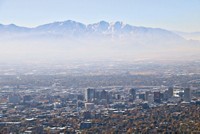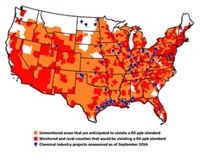Advertisement
Grab your lab coat. Let's get started
Welcome!
Welcome!
Create an account below to get 6 C&EN articles per month, receive newsletters and more - all free.
It seems this is your first time logging in online. Please enter the following information to continue.
As an ACS member you automatically get access to this site. All we need is few more details to create your reading experience.
Not you? Sign in with a different account.
Not you? Sign in with a different account.
ERROR 1
ERROR 1
ERROR 2
ERROR 2
ERROR 2
ERROR 2
ERROR 2
Password and Confirm password must match.
If you have an ACS member number, please enter it here so we can link this account to your membership. (optional)
ERROR 2
ACS values your privacy. By submitting your information, you are gaining access to C&EN and subscribing to our weekly newsletter. We use the information you provide to make your reading experience better, and we will never sell your data to third party members.
Environment
EPA Clean Air Rules Challenged
Republicans, Democrats clash over the costs and benefits of agency’s actions
by Glenn Hess
October 24, 2011
| A version of this story appeared in
Volume 89, Issue 43
Republicans in Congress have sought to block, delay, or weaken a variety of Environmental Protection Agency air pollution rules lately, saying they are simply trying to get rid of excessive, job-destroying regulations during a time of economic weakness. But Democrats accuse the GOP of trying to gut the Clean Air Act, the law that gives EPA its authority to establish air quality standards to protect public health.
“In the debate over EPA issues, it can often seem like two ships passing in the night; one side talking about jobs, and the other discussing children’s health,” Rep. Andrew P. Harris (R-Md.) remarked earlier this month at a congressional hearing.
Harris, chairman of the House of Representatives Science, Space & TechnologySubcommittee on Energy & Environment, convened the Oct. 4 meeting to examine EPA’s process for setting standards under the Clean Air Act.
House Republicans have put the agency at the center of their antiregulatory agenda. In September, the GOP-controlled House passed a wide-ranging bill (H.R. 2401) that would halt EPA efforts to sharply curtail emissions of mercury, soot, and acid gases from coal- and oil-fired power plants and impose stricter limits on toxic air pollution that often drifts across state lines (C&EN, Oct. 3, page 12). The legislation is unlikely to pass the Democratic-led Senate, and the White House has threatened to veto it.
EPA estimates that the targeted regulations would make it possible to “avoid tens of thousands of premature deaths, prevent tens of thousands of heart attacks and thousands of hospital visits for respiratory and cardiovascular disease, and alleviate hundreds of thousands of childhood asthma attacks and other respiratory illnesses.”
Also last month, EPA was expected to finalize a plan to further reduce smog-forming ozone emissions in urban areas. But the White House directed the agency to delay issuing new rules until 2013, citing the country’s stagnant economic recovery as the reason (C&EN, Sept. 12, page 7).
EPA has said the public health benefits from a stricter ozone standard could save the economy as much as $100 billion per year. But business groups lobbied hard against the proposed regulation, saying it would cost at least $1 trillion over a decade to implement and millions of jobs would be lost.
At the recent House subcommittee hearing, Harris noted that air pollution levels in the U.S. have plummeted over the past three decades and most of America meets increasingly stringent EPA standards. Nevertheless, he said, the agency is “moving ahead promulgating major, job-destroying regulations on the basis of shaky and often secret science.”
Harris said the agency usually does not disclose the scientific data or assumptions it uses when determining the health benefits of air pollution rules. “From what we have seen so far, EPA seems to rely on making statistical hay out of minor associations between pollutants and premature mortality,” he remarked.
Harris also noted that EPA’s Office of Inspector General recently released a report that criticized the agency for failing to follow peer review guidelines in evaluating the science it used to back up its finding that carbon dioxide is a dangerous pollutant that can be regulated under the clean air law.
But Rep. Brad Miller of North Carolina, the subcommittee’s top Democrat, accused Republicans of waging a political war against EPA in an effort to hamstring the Obama Administration’s ambitious environmental agenda. “To them, there is no middle ground, and no room for negotiation or compromise with this ‘rogue agency,’ ” Miller said.
“Demonizing environmental safeguards and EPA by making specious claims that regulations kill jobs—and even people—while completely ignoring the proven positive effects they have on public health and the economy, is another cynical ploy to get Americans to vote against their own self-interest,” he charged.
Several scientists invited to testify by the GOP majority told the panel that the U.S. is reaching a point of diminishing returns in setting standards for toxic air pollutants at lower and lower concentrations. Each reduction becomes more difficult and costly to achieve, they argued, while yielding minimal, if any, additional health benefits.
Although the Clean Air Act requires EPA to set air pollution standards that protect the public health with an adequate margin of safety, the agency retains discretionary authority to avoid regulating risks that it reasonably concludes are trivial in context, noted Roger O. McClellan, an adviser to public and private organizations on inhalation toxicology and risk analysis issues.
“Policy judgments are always required in deciding what risks are acceptable,” said McClellan, a former chairman of EPA’s Clean Air Scientific Advisory Committee (CASAC), an independent group of academic and private-sector scientists.
EPA’s standards should be based on “robust scientific data,” said Michael Honeycutt, chief toxicologist for the Texas Commission on Environmental Quality. Instead, he asserted, the agency routinely “misuses scientific studies to justify its policy preferences.”
For example, Honeycutt said, EPA’s own analysis demonstrates that the agency’s proposed rule to establish emission limits for mercury and other hazardous air pollutants for new and existing power plants will not have an effect on mercury levels in fish in U.S. watersheds.
“EPA’s claims of mercury causing lower IQ and heart disease scare the public into avoiding seafood,” Honeycutt remarked. He pointed out that the Japanese eat 10 times more fish than Americans do and have higher levels of mercury in their blood, but they have lower rates of coronary heart disease and high scores on IQ tests.
“To claim that a policy decision is ‘based on the science’ without putting those decisions in appropriate context with real-world implications is not just a misuse of science but causes harm to the public. It is a disservice to her citizens when government exaggerates, misstates, or misleads the public about the ‘real’ risk of environmental effects,” Honeycutt told the panel.
But George D. Thurston, a professor of environmental medicine at New York University School of Medicine, defended the science behind EPA’s air pollution controls.
“The evidence is clear and consistent: Air pollution is adversely affecting the health and lives of Americans across our nation,” he testified. “There is coherence between the epidemiologic study associations and experimental study results, validating that there is indeed a cause-effect relationship between air pollution and adverse human health effects.”
Thurston, a former member of EPA’s CASAC, also said many scientific studies, including his own, support EPA’s plan to tighten the ozone standard. Inhaling low-level atmospheric ozone, he explained, can weaken the immune system and cause lung inflammation, which “can make the elderly more susceptible to pneumonia, a major cause of illness and death in this age group.”
“The science is sound and the results are clear: Cleaning our air reduces air pollution health impacts, lowers our health care costs, and saves lives,” Thurston told the panel.
Although no one from EPA was invited to testify at the hearing, EPA Administrator Lisa P. Jackson toldmembers of the House Energy & Commerce Subcommittee on Oversight & Investigationslast month that it was wrong to tie stricter environmental regulation to declining job opportunities and a poor economy.
“In contrast to doomsday predictions, history has shown, again and again, that we can clean up pollution, create jobs, and grow our economy all at the same time,” Jackson said. Since Congress passed the Clean Air Act 40 years ago, she noted, the gross domestic product of the U.S. has grown by more than 200%.
“Families should never have to choose between a job and a healthy environment. They are entitled to both,” Jackson said. ◾







Join the conversation
Contact the reporter
Submit a Letter to the Editor for publication
Engage with us on Twitter